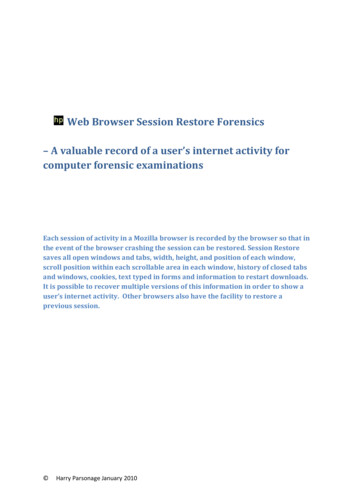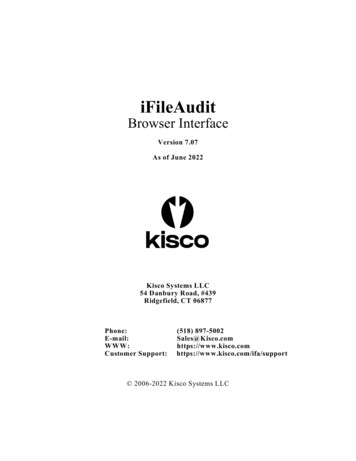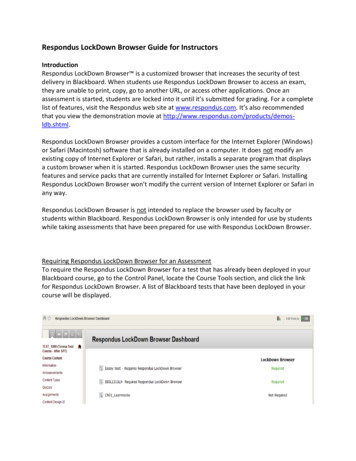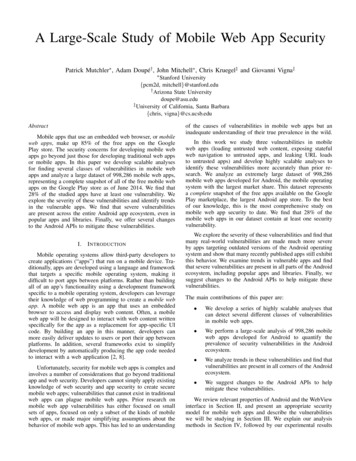
Transcription
Exploring New WebBrowser SecurityCapabilities
Exploring New Web BrowserSecurity CapabilitiesSince the introduction of Secure Web GatewayContentsExploring NewFeatures, Uses forSecure Web GatewayAppliancesWeb Browser SecurityFeatures Make AttacksHarder(SWG), the threats facing companies have continually grownand become more sophisticated. Luckily, new securityfeatures built into popular browsers are making it harderthan ever for cybercriminals to strike. Read this expert EGuide to explore new security capabilities and how they aremaking attacks more difficult.Exploring New Features, Uses for Secure Web GatewayAppliancesBy: Michael Cobb, Application SecurityOriginally, an enterprise would implement a secure Web gateway (SWG)appliance to enforce corporate policy (e.g., preventing employees fromvisiting YouTube during office hours). Back in 2008, as enterprises realizedthey couldn't rely solely on a firewall, antivirus, and simple URL filtering toprevent zero-day attacks, SWGs were viewed as the best way of integratingfeatures provided at that time by various single-purpose devices -- such asURL filtering and bandwidth throttling -- into one appliance. Web applicationlevel controls and centralized management were also big selling points, plusnon-signature-based detection and filtering were beginning to appear.With the threats facing enterprises changing so much since the introductionof SWGs, though, enterprises must reconsider what new features andfunctions are now included with SWGs and which features are the mostimportant when picking a potential implementation. A continually growing andincreasingly sophisticated attacker base, combined with the emergence ofmore diverse endpoints, mobility and BYOD, have all forced SWGtechnology to evolve rapidly to meet the needs of the modern enterprise.In this article, we will reexamine what enterprises should expect from secureWeb gateways in light of the technology's evolution, plus the differencesbetween cloud-based and on-premises SWG appliance deployments.Page 2 of 9Sponsored by
Exploring New Web BrowserSecurity CapabilitiesSecure Web gateway featuresTo maximize the benefits contemporary SWGs provide, an enterprise mustContentsExploring NewFeatures, Uses forSecure Web GatewayAppliancesWeb Browser SecurityFeatures Make AttacksHarderunderstand its requirements and the pros and cons of an on-premises, cloudbased or hybrid SWG deployment.Any organization assessing secure Web gateway options should now expectto find a wide range of functions and features available, including: URL filtering HTTPS scanning Malware detection, both inbound and outbound Threat intelligence feeds Mobile support Application control Data loss prevention (DLP) Threat and traffic visualizationDue to the rapidly changing nature of the threat landscape, enterprisesshould note that differences abound in the quality of controls such as URLfiltering, malware detection and support for DLP. For example, filtering anddetection technology has advanced significantly in recent years. To solve theproblem of outdated blacklists, SWGs now rely on multiple types of analytics,including reputation analysis, real-time browser code scanning, behavioralanalysis, content control and data fingerprinting.Another noticeable advance in modern SWGs is the increased flexibility andgranularity administrators have in controlling Web, email and data traffic.Individual elements within a dynamic Web page can be analyzed andblocked, as can access to specific services at particular times of the day orwhen activity reaches a predefined threshold. Bandwidth utilizationparameters can be specified for uplink and downlink traffic by contentcategory. They can also be adjusted depending on specific accessrequirements for different users and groups.To keep devices updated with the latest threat and attack information, manysecure Web gateway products incorporate threat intelligence feeds fromPage 3 of 9Sponsored by
Exploring New Web BrowserSecurity Capabilitiescloud-based services. DLP support is growing for a variety of mobile devices,which is vital for any enterprise that supports BYOD. By combining securityContentsExploring NewFeatures, Uses forSecure Web GatewayAppliancesWeb Browser SecurityFeatures Make AttacksHarderclassifications with custom data sets, context-aware data loss prevention isalso improving. Many SWGs also support "call home" detection, or alertingon malware that seeks out remote instructions, to help cover any blind spots.Visualization might seem like a gimmicky feature, but it enablesadministrators to easily see hotspots on the network that need furtherattention. For example, visualization of captured traffic can quickly highlightinfected devices probing network neighbors looking for vulnerabilities toexploit. Also, administrators can observe information such as bandwidthutilization or sites visited in real-time, which provides better visual insight intohow a network is being used and how rule changes affect productivity andsecurity. This makes implementing complex rules that perform as intendedmuch easier.Secure Web gateway deployment trendsIn terms of how secure Web gateways are being deployed, the most recentSecure Web Gateway Magic Quadrant 2012 from research firm Gartner Inc.indicated that on-premises enterprise-grade appliances still dominate themarket, but the cloud-based SWG-as-a-Service segment is growing quickly.There are also hybrid deployments available that combine on-premises andcloud-based SWG elements.To maximize the benefits contemporary SWGs provide, an enterprise mustunderstand its requirements and the pros and cons of an on-premises, cloudbased or hybrid SWG deployment. With cloud-based services, an enterprisecan apply the same protection and policies to all users regardless of location,but the enterprise must select an SWG that will integrate with its existinginfrastructure. With an on-premises SWG, a proxy architecture must be usedso that all Web-bound traffic is processed. By forcing all Web traffic toterminate at the proxy, the gateway can ensure no traffic flows to or from theInternet without inspection or control. Alternative SWG deployments, such asTAP deployments, have the gateway observing traffic as it passes bybecause it's sitting off to the side of the network. If the gateway doesn'tdetect the threat in time because the traffic isn't being intercepted as anPage 4 of 9Sponsored by
Exploring New Web BrowserSecurity Capabilitiesinline appliance would, malware or other threats can slip onto the networkunnoticed. This method might be fine for enforcing organizational policy, butContentsExploring NewFeatures, Uses forSecure Web GatewayAppliancesWeb Browser SecurityFeatures Make AttacksHarderit's definitely not a reliable safeguard against Web-borne threats.Finally, as with most Web security technology, the marketing materials forsecure Web gateway products are full of superlative blurbs, such as unique,the best and industry-leading. Enterprises should attempt to ignore theselargely baseless claims when assessing how a certain device can best meetorganizational requirements. Instead, narrow down a list of finalists on howwell each product measures up against a pre-defined list of must-havefeatures, and then use price, performance testing and advice from othercustomers to guide the final decision.There's no question secure Web gateway technology has evolvedconsiderably in recent years with many impressive new capabilities, butadvancement alone is no guarantee of success. A careful, thoughtful reviewof what today's products can do and how they match up against anenterprise's needs is an essential precursor to secure Web gateway success.About the author:Michael Cobb, CISSP-ISSAP, is a renowned security author with more than15 years of experience in the IT industry and another 16 years of experiencein finance. He is the founder and managing director of Cobweb ApplicationsLtd., a consultancy that helps companies to secure their networks andwebsites, and also helps them achieve ISO 27001 certification. He coauthored the book IIS Security and has written numerous technical articlesfor leading IT publications. Michael is also a Microsoft Certified DatabaseAdministrator and a Microsoft Certified Professional.Web Browser Security Features Make Attacks HarderBy: Robert Westervelt, News DirectorSecurity capabilities built into popular browsers are making it more difficultthan ever for cybercriminals to carry out attacks using browser vulnerabilities,according to security experts. While the security improvements don’t makePage 5 of 9Sponsored by
Exploring New Web BrowserSecurity Capabilitiesbrowsers bulletproof, recent hacking contests demonstrate the overallenhanced state of browser security.ContentsExploring NewFeatures, Uses forSecure Web GatewayAppliancesWeb Browser SecurityFeatures Make AttacksHarderMicrosoft, Mozilla and Google have all been developing support forsubstantial security capabilities in recent years that isolate criticalcomponents and help prevent attackers from using the browser as a steppingstone to a more substantial attack, says Chris Valasek, senior researchscientist at Accuvant Labs.―It’s accepted that users will click on links and browsers will be exploited, butif you have something to contain the attack you are going to be much betteroff,‖ Valasek says. ―As long as there are smart attackers out there with timeon their hands they’re going to take vulnerabilities and create something toexploit them, but we’re seeing that it’s taking more time and more effort.‖At RSA Conference 2012, Valasek and his team, which includes researchersJoshua Drake and Paul Mehta, talked about Web browser security featuresand the results of their browser security analysis of Mozilla Firefox, MicrosoftInternet Explorer and Google Chrome. The analysis found all three browserscontain capabilities that make an attacker’s job much harder. The AccuvantLabs researchers praised Google’s implementation of sandboxing in Chromefor making it an extremely difficult browser to crack. Sandbox technology –also implemented in Internet Explorer – is intended to contain certain actions,such as code execution.―While not perfect, sandboxes do provide a huge barrier of entry of anypersistence on anyone’s machine,‖ Valasek says. ―It might make an attackerlook for lower hanging fruit.‖Both IE and Chrome also support JIT hardening, a function that reduces theimpact of vulnerabilities in other software. The browser JIT engine is amongthe favorite targets of attackers.All three browsers use address space layout randomization (ASLR) and dataexecution prevention (DEP), technologies designed to prevent an attackerfrom using well-known locations to begin exploitation and from exploitingPage 6 of 9Sponsored by
Exploring New Web BrowserSecurity Capabilitiescode in certain regions of memory. The browsers also contain a stackcookies function, which is designed to prevent stack-based buffer overflows,ContentsExploring NewFeatures, Uses forSecure Web GatewayAppliancesWeb Browser SecurityFeatures Make AttacksHardera common component to a successful attack.―We can beat up on Firefox or Internet Explorer and even Chrome, but all ofthese browsers improved drastically since where they were at four yearsago,‖ Drake says.However, as with any security technology, there is no silver bullet, he adds.All of the security features contain weaknesses that can be exploited by askilled attacker. Still, the increasingly difficult nature of carrying out an attacktargeting the browser vulnerability was put on display in March at theCanSecWest security conference in Vancouver BC, where Google and HPTippingPoint held their annual browser busting contests. While severalwinners were crowned, the contestants reportedly admitted that it took longhours to string together an attack scenario that enabled them to break out ofthe browser and onto the machine.A team of researchers from VUPEN Security strung together multiplevulnerabilities in a complex exploit to garner 60,000 from Google. Otherwhite hat hackers in the contest failed to pull off a complete attack. Thisyear’s contest stood in stark contrast to years past when multiple securityresearchers took mere minutes to demonstrate a vulnerability and compete asuccessful browser attack.For the Pwn2Own contest run by HP’s TippingPoint Zero Day Initiative, theresearch team from VUPEN demonstrated a successful attack againstChrome and Internet Explorer, while independent researchers VincenzoIozzo and Willem Pinckaers teamed up to successfully exploit a Firefox zeroday flaw.Despite the improvements in browser security, spear phishing and otheremail attacks targeting browser vulnerabilities and browser components likeAdobe Flash and other plugins, are almost constant and a serious problemfor enterprises says Anup Gosh, founder and chief technology officer ofhardened-browser maker Invincea. Gosh, who received funding from DARPAPage 7 of 9Sponsored by
Exploring New Web BrowserSecurity Capabilitiesto create a virtual sandbox browser environment that supports InternetExplorer and Firefox, says a lot of organizations are still using outdatedContentsExploring NewFeatures, Uses forSecure Web GatewayAppliancesWeb Browser SecurityFeatures Make AttacksHarderPage 8 of 9browsers with fewer security features to support custom applications.―When you talk to people who clean up networks and the incident responseguys, it’s all spear phishing right now,‖ Gosh says. ―It’s not hard to get a userto click on a link and exploit a browser component vulnerability. Theweaknesses are still there.‖About the author:Robert Westervelt is news director of SearchSecurity.com.Sponsored by
Exploring New Web BrowserSecurity CapabilitiesContentsFree resources for technology professionalsTechTarget publishes targeted technology media that address your need forExploring NewFeatures, Uses forSecure Web GatewayAppliancesinformation and resources for researching products, developing strategy andWeb Browser SecurityFeatures Make AttacksHarderwebcasts, podcasts, videos, virtual trade shows, research reports and moremaking cost-effective purchase decisions. Our network of technology-specificWeb sites gives you access to industry experts, independent content andanalysis and the Web’s largest library of vendor-provided white papers,—drawing on the rich R&D resources of technology providers to addressmarket trends, challenges and solutions. Our live events and virtual seminarsgive you access to vendor neutral, expert commentary and advice on theissues and challenges you face daily. Our social community IT KnowledgeExchange allows you to share real world information in real time with peersand experts.What makes TechTarget unique?TechTarget is squarely focused on the enterprise IT space. Our team ofeditors and network of industry experts provide the richest, most relevantcontent to IT professionals and management. We leverage the immediacy ofthe Web, the networking and face-to-face opportunities of events and virtualevents, and the ability to interact with peers—all to create compelling andactionable information for enterprise IT professionals across all industriesand markets.Related TechTarget WebsitesPage 9 of 9Sponsored by
Secure Web gateway deployment trends In terms of how secure Web gateways are being deployed, the most recent Secure Web Gateway Magic Quadrant 2012 from research firm Gartner Inc. indicated that on-premises enterprise-grade appliances still dominate the market, but the cloud-based SWG-as-a-Service segment is growing quickly.










